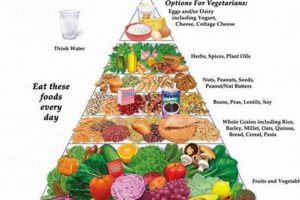Plant-based alternatives to traditional holiday fare are increasingly popular, particularly during seasonal celebrations. This encompasses a range of dishes that exclude animal products while maintaining festive appeal. Examples include lentil loaves replacing ham, cashew-based cheesecakes instead of dairy-laden desserts, and chocolate-free treats crafted with ingredients like avocado and dates.
The rising interest in such culinary options reflects growing awareness of ethical, environmental, and health considerations. Choosing plant-based recipes contributes to animal welfare, reduces the environmental impact associated with animal agriculture, and aligns with dietary preferences or restrictions. Historically, certain cultures have long incorporated plant-based meals into their festive traditions, though the conscious exclusion of all animal products is a more recent development.
The following sections will delve into specific categories of seasonal, plant-based recipes, offering guidance on recipe selection, ingredient substitutions, and considerations for creating a complete and satisfying holiday feast that aligns with these principles.
Plant-Based Holiday Preparation
Preparation for a plant-based holiday celebration requires careful planning to ensure a satisfying and inclusive culinary experience.
Tip 1: Strategic Menu Planning: Carefully consider all elements of the meal, from appetizers to desserts. Map out each course with specific plant-based dishes in mind, ensuring a balanced array of flavors and textures. Prioritize recipes that utilize seasonal produce for optimal taste and freshness.
Tip 2: Ingredient Sourcing: Locate reliable sources for plant-based ingredients. Specialty stores or online retailers may offer unique or hard-to-find items, such as plant-based cheeses or meat alternatives. Explore local farmers’ markets for fresh, seasonal vegetables and fruits.
Tip 3: Advance Preparation: Many plant-based dishes can be prepared in advance, reducing stress on the day of the celebration. Soups, stews, and certain desserts often improve in flavor when allowed to sit overnight. Proper storage is essential to maintain food safety and quality.
Tip 4: Flavor Enhancement: Plant-based cuisine benefits from strategic use of herbs, spices, and umami-rich ingredients. Experiment with smoked paprika, nutritional yeast, and dried mushrooms to add depth and complexity to dishes. Lemon juice or vinegar can brighten flavors and balance richness.
Tip 5: Allergen Awareness: Be mindful of potential allergens, such as nuts, soy, or gluten, when preparing plant-based meals. Clearly label dishes containing common allergens, or offer alternative options for guests with dietary restrictions.
Tip 6: Visually Appealing Presentation: Enhance the dining experience by paying attention to presentation. Arrange dishes attractively on platters and garnish with fresh herbs or edible flowers. Thoughtful presentation elevates the perception and enjoyment of the meal.
Tip 7: Recipe Testing: Prior to the holiday, test any new or unfamiliar recipes to ensure their success. This allows for adjustments to ingredients or cooking techniques, preventing potential mishaps on the day of the celebration.
These strategies facilitate a successful and enjoyable plant-based holiday gathering, showcasing the versatility and appeal of plant-based cuisine.
The subsequent sections will provide specific recipe suggestions and further guidance for crafting a memorable plant-based holiday menu.
1. Ethical considerations
Ethical considerations are a primary driver behind the increasing adoption of plant-based diets, particularly evident in holiday meals such as those prepared for Easter. The core principle involves minimizing harm to animals, challenging the conventional use of animal products in celebratory dishes. The production of meat, dairy, and eggs often entails practices that raise ethical concerns related to animal welfare, including confinement, separation of offspring from parents, and premature slaughter. For example, the consumption of lamb, traditionally associated with Easter, necessitates the raising and eventual slaughter of lambs, practices that are scrutinized by animal welfare advocates.
The shift towards plant-based cuisine for Easter directly addresses these ethical concerns. Individuals seeking to align their dietary choices with their values opt for alternatives that avoid contributing to the perceived suffering of animals. This can manifest in the selection of dishes like lentil roasts instead of lamb, or the creation of plant-based “eggs” using ingredients such as cashews and vegetable dyes. The importance of ethical considerations lies in its direct influence on consumer choices and its contribution to a broader dialogue about responsible food systems. The practical significance is demonstrated by the growing market for plant-based products and the increasing availability of vegan recipes for traditional holiday meals.
In summary, ethical concerns are a fundamental component of the plant-based movement, particularly regarding food. The movement challenges individuals to reassess their relationship with animal products and to consider the ethical implications of their dietary choices. While challenges remain in navigating misinformation and ensuring equitable access to plant-based options, the increasing awareness of ethical considerations signals a growing shift towards more responsible and compassionate food practices during Easter and throughout the year.
2. Ingredient Substitutions
The preparation of plant-based holiday meals inherently necessitates strategic ingredient substitutions, forming a crucial aspect of creating palatable and festive dishes. The success of vegan adaptations of traditional recipes depends heavily on understanding the functional properties of original ingredients and selecting appropriate plant-based alternatives. For instance, eggs, commonly used as binding agents and leavening agents, require substitutes such as flaxseed meal or aquafaba (chickpea brine), which mimic these properties. Butter, a primary component in many baked goods, can be replaced with plant-based oils or nut butters, each imparting different textural and flavor nuances. The selection of appropriate substitutes directly impacts the dishs final texture, flavor, and overall appeal.
Examples of practical substitutions abound in plant-based holiday cooking. Traditional dairy-based sauces can be recreated using cashew cream or coconut milk, offering similar richness and viscosity. Honey, a common sweetener, can be replaced with maple syrup, agave nectar, or date syrup, each providing distinct sweetness levels and flavor profiles. Meat alternatives, such as seitan or tempeh, can be used to mimic the texture and protein content of traditional meats. Furthermore, inventive substitutions can enhance the nutritional profile of dishes; for example, replacing refined flour with whole wheat flour or incorporating vegetables into traditionally carbohydrate-heavy recipes.
In conclusion, thoughtful ingredient substitutions are paramount in creating plant-based holiday meals that are both delicious and align with ethical and dietary preferences. Mastering these substitutions allows for faithful recreations of classic recipes, while also enabling the creation of entirely new and innovative dishes. While sourcing appropriate ingredients and understanding their functional properties presents a challenge, the resulting culinary creations offer a fulfilling and responsible approach to holiday celebrations.
3. Recipe Adaptations
Recipe adaptations are central to the creation of plant-based versions of traditional holiday fare. They bridge the gap between conventional cooking methods and the constraints of a vegan diet, enabling familiar flavors and textures to be replicated using plant-derived ingredients.
- Egg Replacements in Baking
The adaptation of baking recipes frequently hinges on successful egg substitution. Eggs serve multiple functions, including binding, leavening, and adding moisture. Plant-based alternatives, such as flaxseed meal mixed with water, aquafaba (chickpea brine), or commercial egg replacers, attempt to mimic these properties. For example, a traditional Easter cake recipe might require significant modification to achieve the desired rise and crumb structure without eggs, necessitating careful adjustments to liquid ratios and baking times.
- Dairy-Free Sauces and Creams
Many holiday recipes rely on dairy for richness and flavor. Adapting these recipes for a plant-based diet involves substituting dairy milk with plant-based alternatives like almond, soy, or oat milk. Cream sauces, for instance, can be replicated using cashew cream or blended silken tofu, altering the flavor profile slightly but maintaining the desired texture. A classic Easter gratin may use a cashew-based sauce instead of cream, requiring consideration of nut allergies among guests.
- Meatless Main Courses
Traditional Easter celebrations often feature meat-centric main courses, such as ham or lamb. Adapting these requires replacing the meat with plant-based alternatives that provide sufficient protein and satiety. Lentil loaves, mushroom wellingtons, or seitan roasts are common substitutes. These adaptations often involve significant changes to the overall recipe structure, focusing on umami-rich ingredients and careful seasoning to compensate for the absence of meat flavors. A vegan Shepherd’s pie, substituting lentils for lamb, exemplifies this adaptation.
- Gelatin Substitutions in Desserts
Many desserts, particularly those with a molded or set texture, rely on gelatin, an animal-derived product. Adapting these recipes for a vegan diet involves substituting gelatin with plant-based alternatives like agar-agar or carrageenan, derived from seaweed. These alternatives require careful measurement and specific preparation techniques to achieve the desired setting consistency. A vegan panna cotta, using agar-agar instead of gelatin, demonstrates this adaptation.
These recipe adaptations illustrate the complex process of translating traditional culinary practices into the realm of plant-based cuisine. Successful adaptations demand a thorough understanding of ingredient functionality and a willingness to experiment with new techniques. The outcome is a range of plant-based dishes that capture the essence of traditional holiday flavors while adhering to vegan principles.
4. Nutritional balance
Achieving nutritional balance within plant-based meals prepared for Easter is paramount. A dietary shift away from traditional animal-derived dishes necessitates careful consideration of nutrient adequacy to prevent deficiencies. The absence of meat, dairy, and eggs can potentially reduce intakes of protein, vitamin B12, iron, calcium, and omega-3 fatty acids, all of which play vital roles in maintaining physiological function. Therefore, meticulous meal planning is crucial to ensure these nutrients are adequately supplied from plant-based sources. For example, a traditional Easter ham might be replaced with a lentil loaf, requiring the incorporation of other protein-rich plant foods, such as nuts, seeds, or quinoa, to meet protein requirements. The intentional design of meals becomes a strategic imperative to prevent nutritional compromise.
Practical applications of this understanding involve consciously selecting nutrient-dense plant-based ingredients. Fortified plant-based milks can serve as sources of vitamin B12 and calcium, addressing potential deficiencies associated with dairy elimination. Iron-rich foods, like spinach and legumes, should be strategically included, and their absorption can be enhanced by consuming them with vitamin C-rich foods. Omega-3 fatty acids can be obtained from flaxseeds, chia seeds, and walnuts, although their conversion to usable forms of omega-3s may be less efficient than from animal sources, warranting consideration of algal oil supplements. The mindful combination of these ingredients allows for the creation of complete and balanced plant-based Easter meals. A plant-based quiche, featuring tofu and diverse vegetables, exemplifies such an application, providing protein, vitamins, and minerals.
In summary, nutritional balance is an indispensable component of plant-based Easter meals. Addressing potential nutrient gaps through thoughtful ingredient selection and strategic meal planning is critical for ensuring health and well-being. While challenges may arise in navigating conflicting nutritional information and adapting to new dietary patterns, the long-term benefits of a well-planned plant-based diet, aligned with ethical and environmental considerations, warrant diligent attention to nutrient adequacy.
5. Seasonal Availability
Seasonal availability significantly impacts the composition and appeal of festive, plant-based culinary offerings. The selection of ingredients for holiday meals is often influenced by the time of year, with seasonal produce contributing to freshness, flavor, and visual appeal.
- Spring Vegetables
Spring vegetables such as asparagus, peas, and new potatoes become prominent ingredients. Their tender textures and vibrant colors align with the aesthetic of springtime celebrations. For plant-based holiday recipes, these vegetables can be incorporated into dishes like tarts, salads, and vegetable medleys, offering both nutritional value and seasonal relevance. Asparagus spears grilled and served with a lemon-herb dressing exemplify this.
- Seasonal Fruits
Fruits available in spring, such as strawberries and rhubarb, offer opportunities for creating plant-based desserts. These fruits can be used in crumbles, pies, and vegan cheesecakes, adding natural sweetness and refreshing flavors. A rhubarb crumble with an oat-based topping demonstrates the integration of seasonal fruits into festive plant-based desserts.
- Herb Utilization
Fresh herbs, readily available during spring, play a crucial role in enhancing the flavor profiles of plant-based dishes. Herbs like mint, parsley, and chives can be used in sauces, dressings, and as garnishes, adding complexity and freshness to both savory and sweet preparations. A mint-infused pea soup represents this utilization.
- Ingredient Sourcing Challenges
While seasonal availability offers advantages, it can also pose challenges. Reliance on specific seasonal ingredients may limit recipe options, particularly if certain items are not readily accessible in all regions. The planning of a plant-based meal requires consideration of these logistical constraints, potentially necessitating substitutions or adjustments based on local availability.
Incorporating seasonal ingredients into plant-based holiday meals enhances the dining experience, promoting sustainability and aligning with the natural rhythms of the year. The careful selection and utilization of these ingredients contribute to the overall appeal and nutritional value of festive, plant-based cuisine, ensuring a meal that is both satisfying and seasonally appropriate.
6. Festive presentation
Festive presentation plays a crucial role in the acceptance and enjoyment of plant-based dishes served during Easter celebrations. The visual appeal of food significantly impacts perception and willingness to try new or unfamiliar items. In the context of plant-based cuisine, which may deviate from traditional Easter fare, careful attention to presentation can mitigate potential resistance and enhance the dining experience. A beautifully arranged lentil roast, garnished with fresh herbs and strategically placed roasted vegetables, is more likely to be perceived favorably than a simply plated version of the same dish.
Considerations for enhancing visual appeal include the use of vibrant colors, varied textures, and intentional plating techniques. A plant-based Easter dessert, such as a cashew-based cheesecake, can be elevated with fresh fruit toppings arranged in an aesthetically pleasing manner. The use of edible flowers and strategically placed drizzles of plant-based chocolate sauce contribute to the overall visual impact. Furthermore, the selection of serving dishes and table settings can complement the food, creating a cohesive and appealing dining environment. A table adorned with spring-themed linens and floral arrangements further enhances the festive atmosphere.
In summary, festive presentation is an essential component of successful Easter plant-based meals. It addresses potential biases against unfamiliar dishes and enhances the overall dining experience. While achieving visually appealing results requires effort and attention to detail, the positive impact on perception and enjoyment makes it a worthwhile investment. Challenges may arise in balancing aesthetic considerations with practical constraints, but the conscious effort to enhance the visual appeal of plant-based dishes contributes to a more inclusive and enjoyable celebration.
7. Flavor Profiles
Flavor profiles are integral to the success of any culinary endeavor, and their importance is amplified when adapting traditional meals, such as those prepared for Easter, to plant-based diets. The absence of familiar animal-derived ingredients necessitates a strategic approach to flavor development, compensating for the loss of umami, richness, and textural complexity that these ingredients typically provide. The creation of satisfying plant-based alternatives hinges on the ability to construct balanced and appealing flavor profiles that resonate with both traditional palates and those accustomed to vegan cuisine. A plant-based shepherds pie, for instance, must recreate the savory depth of the original by layering flavors from mushrooms, lentils, and herbs, rather than relying solely on the taste of lamb.
Practical application of this understanding involves the exploration of techniques to enhance specific flavor characteristics. The Maillard reaction, responsible for browning and savory flavors, can be encouraged in plant-based dishes through careful searing and roasting. Umami can be amplified by incorporating ingredients like dried mushrooms, nutritional yeast, and fermented products such as soy sauce or miso. Sweetness can be derived from natural sources like maple syrup or dates, and acidity can be added through citrus juices or vinegars to balance richness. Consider a vegan hollandaise sauce: replacing the egg yolk and butter necessitates the use of ingredients like cashews, lemon juice, and turmeric to achieve a similar richness, tang, and color. Experimentation and iterative adjustments are often required to achieve optimal flavor balances.
In conclusion, mastering flavor profiles is crucial for the successful adaptation of Easter meals to plant-based diets. Understanding the interplay of different flavors and textures, and employing techniques to enhance specific characteristics, allows for the creation of satisfying and flavorful plant-based alternatives. The challenge lies in accurately replicating familiar flavors using entirely different ingredients, but the rewards are significant: delicious, ethical, and inclusive holiday meals that cater to a wider range of dietary preferences and values.
Frequently Asked Questions
The following section addresses common inquiries and misconceptions regarding plant-based culinary options for the Easter holiday, providing factual information and clarifying potential areas of confusion.
Question 1: Is “Easter vegan food” limited to salads and vegetable-based dishes?
No, plant-based alternatives for Easter extend far beyond simple salads. The spectrum encompasses a wide variety of dishes, including lentil roasts, plant-based wellingtons, vegan quiches, and cashew-based cheesecakes. These dishes are designed to mimic the flavors and textures of traditional holiday fare while excluding animal products.
Question 2: Does preparing “Easter vegan food” require advanced culinary skills?
While some recipes may require moderate skill, many plant-based options are relatively simple to prepare. Numerous online resources and cookbooks offer beginner-friendly recipes and step-by-step instructions for creating satisfying plant-based meals.
Question 3: Are plant-based alternatives for Easter nutritionally adequate?
A well-planned plant-based menu can provide all essential nutrients. Careful consideration must be given to ensuring adequate protein, vitamin B12, iron, calcium, and omega-3 fatty acids are included through strategic ingredient selection and, if necessary, supplementation.
Question 4: Can traditional Easter recipes be easily adapted for a plant-based diet?
Many traditional recipes can be adapted using plant-based substitutions. Eggs can be replaced with flaxseed meal or aquafaba, dairy milk with plant-based alternatives, and meat with legumes, tofu, or seitan. Success often hinges on understanding the functional properties of ingredients and making appropriate adjustments.
Question 5: Is “Easter vegan food” more expensive than traditional Easter meals?
The cost can vary depending on ingredient choices and availability. While some specialty plant-based products may be pricier, many staple ingredients like lentils, beans, and seasonal vegetables are relatively inexpensive. Strategic planning and bulk purchasing can help control costs.
Question 6: Is it challenging to find plant-based options that appeal to non-vegans during Easter?
Carefully selected and well-prepared plant-based dishes can appeal to a broad range of palates. Emphasizing flavor, texture, and visual presentation can enhance the dining experience and encourage non-vegans to try and appreciate plant-based cuisine.
The key takeaway is that preparing plant-based meals for Easter is both feasible and potentially rewarding. With careful planning, strategic ingredient substitutions, and attention to detail, satisfying and nutritionally balanced meals can be created that align with ethical and dietary preferences.
The following section will delve into specific recipe ideas.
Conclusion
This exploration of “easter vegan food” has illuminated the ethical, nutritional, and practical considerations associated with plant-based alternatives to traditional holiday meals. Key aspects include the importance of ingredient substitutions, recipe adaptations, maintaining nutritional balance, leveraging seasonal availability, and enhancing festive presentation. The strategic implementation of these elements allows for the creation of inclusive and satisfying meals that align with diverse dietary preferences.
The ongoing shift toward plant-based cuisine signals a growing awareness of the environmental and ethical impacts of food choices. Embracing plant-based alternatives for celebratory meals, such as those prepared for Easter, represents a tangible step towards a more sustainable and compassionate food system. Continued innovation and accessibility within the plant-based food sector hold the potential to further transform culinary traditions and promote responsible consumption practices.







